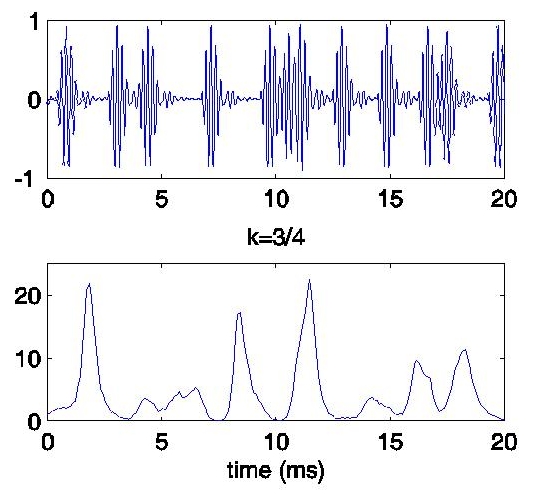Recovery from Binaural Adaptation in Normal Hearing Listeners (ITD Jitter NH)
Objective
The sensitivity of normal hearing (NH) listeners to interaural time differences (ITD) in the envelope of high-frequency carriers is limited with respect to the envelope modulation rate. Increasing the envelope rate reduces the sensitivity, an effect that has been termed binaural adaptation (Hafter and Dye, 1983). In another study (Laback and Majdak, 2008), it was hypothesized that introducing binaural jitter may improve ITD sensitivity in bilateral cochlear implant (CI) listeners by avoiding periodicity. Indeed, the results showed large improvements at high rates (≥ 800 pps). This was interpreted as an indication for a recovery from binaural adaptation.
In this study, we further investigated this effect using NH subjects. We attempted to understand the underlying mechanisms by applying a well-established model of peripheral auditory processing.
Method and Results
Bandpass-filtered clicks (4 kHz) with a pulse rate of 600 pps were used at a nominal pulse rate of 600 pulses per second (pps). It was found that randomly jittering the timing of the pulses significantly increases detectability of the ITD. A second experiment was performed to observe the effect of place and rate for pulse trains. It was shown that ITD sensitivity for jittered pulse trains at 1200 pps were significantly higher than periodic pulse trains at 600 pps. Therefore, with the addition of jitter, listeners were not solely benefiting from the longest interpulse intervals and instances of reduced rate. A third experiment, using a 900 pps pulse train, confirmed the improvement in ITD sensitivity. This occurred even when random amplitude modulation, a side-effect in the case of large amounts of jitter, is ruled out. A model of peripheral auditory processing up to the brain stem (Nucleus Cochlearis) has been applied to study the mechanisms underlying the improvements in ITD sensitivity. It was found that the irregular timing of the jittered pulses increases the synchrony of firing of the cochlear nucleus. These results suggest that a recovery from binaural adaptation activated by a temporal irregularity is possibly occurring at the level of the cochlear nucleus.
Application
Together with the results of Laback and Majdak (2008) on the effect of binaural jitter in CI listeners, these results suggest that the binaural adaptation effect first observed by Hafter and Dye (1983) is related to the synchrony of neural firings across auditory nerve fibers. The nerve fibers, in turn, innervate cochlear nucleus cells. At higher rates, periodic pulse trains result in little synchrony of the response to the ongoing signal. Jittering the pulse timing increases the probability of synchronous firing across AN fibers at certain instances of time. Further studies are required to determine if other aspects of binaural adaptation can also be attributed to this explanation.
Funding
Internal
Publications
- Goupell, M. J., Laback, B., Majdak, P. (2009): Enhancing sensitivity to interaural time differences at high modulation rates by introducing temporal jitter, in: J. Acoust. Soc. Am. 126, 2511-2521.
- Laback, B., and Majdak, P. (2007): Binaural jitter improves interaural time-difference sensitivity of cochlear implantees at high pulse rates, in: Proc. Natl. Acad. Sci. USA (PNAS) 105, 2, 814-817.
- Laback, B., and Majdak, P. (2008): Reply to van Hoesel: Binaural jitter with cochlear implants, improved interaural time-delay sensitivity, and normal hearing, letter to Proc. Natl. Acad. Sci. USA 12, 105, 32.
